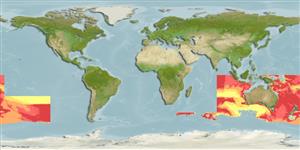Elasmobranchii (tubarões e raias) (sharks and rays) >
Carcharhiniformes (Ground sharks) >
Pentanchidae (Deepwater catsharks)
Etymology: Apristurus: a-, Latin privative, i.e., without; pristis, from pristes (Gr.), sawyer (but here meaning saw); oura (Gr.), tail, referring to absence of saw-toothed crest of enlarged dermal denticles along upper edge of caudal fin as found in the closely related Pristiurus (=Galeus). (See ETYFish); australis: Latin for southern, referring to its distribution in the southern hemisphere around Australia. (See ETYFish).
Environment: milieu / climate zone / depth range / distribution range
Ecologia
marinhas batipelágico; intervalo de profundidade 486 - 1035 m (Ref. 76943). Subtropical
Indian and Pacific coasts of Australia.
Length at first maturity / Tamanho / Peso / Idade
Maturity: Lm 50.0, range 45 - 55 cm
Max length : 61.6 cm TL macho/indeterminado; (Ref. 76943)
Descrição breve
Morfologia | Morfometria
This species has the following characters: flattened prenarial snout, apparently longer than interorbital width; furrows of upper labial much longer than the lower ones; pectoral fin widely expanding posteriorly, with outer margin a little longer than P1-P2 space; short abdomen, P1-P2 space narrower than preorbital length or anal fin base length; origin of first dorsal-fin just above or slightly anterior to pelvic-fin insertion; 50–64 and 48–68 tooth rows on upper and lower jaws, respectively; teeth with 5 or more cusps, including the anterior ones; egg capsule with no coiled tendrils on anterior and posterior ends, posterior end tapering toward tip; color preserved in alcohol is uniformly pale brownish to light greyish, sometimes light yellowish brown; the dorsal side of body is a little darker than ventral side (Ref. 76943).
Life cycle and mating behavior
Maturidade | Reprodução | Desova | Ovos | Fecundidade | Larvas
Sato, K., K. Nakaya and M. Yorozu, 2008. Apristurus australis sp. nov., a new long-snout catshark (Chondrichthyes: Carcharhiniformes: Scyliorhinidae) from Australia. pp. 113-122. In Last, P.R., White, W.T. & Pogonoski, J.J. (eds.): Descriptions of New Australian Chondrichthyans. CSIRO Marine and Atmospheric Research Paper No. 22. (Ref. 76943)
Categoria na Lista Vermelha da IUCN (Ref. 130435)
Ameaça para o homem
Harmless
Utilização humana
Mais informação
Idade/TamanhoCrescimentoComprimento-pesoComprimento-comprimentoFrequência de comprimentoMorfometriaMorfologiaLarvasDinâmica larvarRecrutamentoAbundânciaBRUVS
ReferênciasAquaculturaPerfil para aquaculturaEstirpesGenéticaElectrophoresesHereditariedadeDoençasProcessamentoNutrientsMass conversion
ColaboradoresFotografiasStamps, Coins Misc.SonsCiguateraVelocidadeTipo de nataçãoÁrea branquialOutras referênciasCérebrosVisão
Ferramentas
Relatórios especiais
Descarregue XML
Fontes da internet
Estimates based on models
Preferred temperature (Ref.
123201): 2 - 8.7, mean 6.7 °C (based on 238 cells).
Phylogenetic diversity index (Ref.
82804): PD
50 = 0.5000 [Uniqueness, from 0.5 = low to 2.0 = high].
Bayesian length-weight: a=0.00355 (0.00176 - 0.00714), b=3.09 (2.91 - 3.27), in cm total length, based on LWR estimates for this (Sub)family-body shape (Ref.
93245).
Nível Trófico (Ref.
69278): 3.9 ±0.4 se; based on size and trophs of closest relatives
Resiliência (Ref.
120179): Muito baixo, tempo mínimo de duplicação da população maior que 14 anos (Fec assumed to be < 10).
Fishing Vulnerability (Ref.
59153): Moderate vulnerability (45 of 100).
